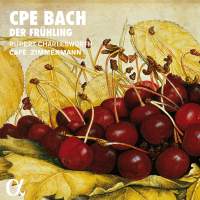Texte paru dans: / Appeared in: Alpha |
|
|
Outil de traduction ~ (Très approximatif) |
|
|
Reviewer: Michael
De Sapio Here we have a mix of never-before-recorded vocal and instrumental music from different periods of C. P. E. Bach’s career. The featured vocal work is the secular cantata Der Frühling (Spring), to a poem by Christoph Martin Wieland. Bach originally wrote it as a song for voice and pianoforte in 1760 but 10 years later remade it into a chamber cantata for tenor and small string ensemble. The text speaks of nature in rapturous, almost religious tones, and Bach clothes it in music of vernal freshness. Interestingly, the piece eschews unity of key; it begins in D Major and ends in B♭. The four tenor arias are gracefully brief. Their moralistic Enlightenment texts extol freedom and virtue and speak of the brevity of life and the equalizing effect of death. Bach’s music is succinct and tuneful.
The short F-Minor cantata Selma from 1776 is altogether different. It is a passionate love poem; a sample: “Your heart, O Selma, full of sweet torment / Secretly quivers for me / And beautiful tears of longing / Well up in her radiant blue eyes!” Like Der Frühling, this piece started life as a song for voice and piano and was later expanded. Listening to these aphoristic tenor songs, we can sense the atmosphere which Mozart was breathing when he wrote The Magic Flute.
The instrumental offerings comprise two trio sonatas for two violins and continuo and a curious sonatina—curious both because it seems to defy genre classification (it is a sort of ensemble piece with a prominent solo keyboard part) and also because, like Der Frühling, it lacks unity of key, having one movement in D Minor and two in F Major. It is a bit too mannered in style for this listener’s taste. The trio sonatas are another story. The A-Minor one has a typically restless, edgy opening movement with wide leaps in the first violin part. The B♭ one opens with a vernal movement reminiscent of Der Frühling. The slow movement Largo con sordini is innovative in texture, with phrases traded between the two muted violins alongside pizzicato passages in thirds. The last movement is brimming with urgent syncopation and counterpoint. Selma and the sonatina add pairs of flutes to the ensemble mix, and the latter adds a pair of horns as well. The best thing about the performances is Rupert Charlesworth’s honeyed and resonant English tenor voice, which is a pleasure to hear. As for the instrumental contributions, they have a bit too much adrenaline for my taste. There seems to be an idea out there that C. P. E. Bach’s music requires a relentlessly active and sharp-angled style of performance, whereas it seems to me that most of his angularity is written into the notes themselves and that one doesn’t need to overemphasize it in execution. The marcato nature of the A-Minor Sonata’s outer movements is overdone, and there is a tendency to push the tempo, which leads to a certain instability in a piece such as the heavily syncopated last movement of the B♭ major sonata. Aggressive continuo playing seems to be a growing trend these days, and it is not a positive one. It’s not necessary for a continuo cellist to play transitional lead-ins as if he’s ramming a cart through the mud. However, in a movement such as the B♭ Sonata’s Largo these musicians show the delicacy and refinement of which they are capable. Booklet notes are by musicologist Peter Wollny and are solid. Documentation on the performers is minimal; there is no information whatsoever about Rupert Charlesworth, although the producers did see fit to devote a whole page to an advertisement for the latest music-storing app. Despite my reservations about the instrumental side, this album is worth hearing for some lesser-known works by C. P. E. Bach—particularly the vocal works, which are spiritually so characteristic of their time—and for the fine singing. But I think some Baroque instrumentalists these days ought to take a nice cup of chamomile tea before performing. | |
|
Support us financially by purchasing this disc from eiher one of these suppliers. Un achat via l'un ou l'autre des fournisseurs proposés contribue à défrayer les coûts d'exploitation de ce site. |
|
|
|
|
|
Cliquez l'un ou l'autre
bouton pour découvrir bien d'autres critiques de CD |
|




